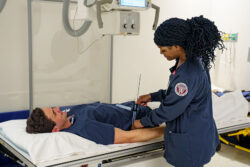WCCD Awarded Over $2.7 Million to Expand Rural Healthcare Education

Through the Neighbors in Health initiative, students will move from early career exploration to completion of degree and certificate programs like Radiologic Technology (shown above).
Wallace Community College-Dothan (WCCD) has received more than $2.7 million from the Alabama Community College System (ACCS) as part of the Alabama Centers for Rural Healthcare Opportunity legislative appropriation. The grant will fund Neighbors in Health: Rural Healthcare Training Close to Home, a major initiative designed to strengthen the rural healthcare workforce, expand training opportunities in southeast Alabama, and support students from rural communities pursuing healthcare careers.
“This funding represents a transformative opportunity for our region,” said Dr. Kathy L. Murphy, WCCD President. “Neighbors in Health will allow us to grow our own healthcare professionals right here at home, while ensuring rural communities receive the care and attention they deserve.”
The community-based initiative is a collaborative effort between WCCD, multiple healthcare providers, high schools, clinical facilities, local governments, and regional workforce and economic development organizations. Its design reflects a shared commitment to “train close to home, serve close to home.”
“Our vision is to help students see themselves as part of the solution for their community,” Dr. Murphy added. “When students from small towns are given access to high-quality training and clinical experiences nearby, they are far more likely to stay, work, and invest in those same communities.”
Through the Neighbors in Health initiative, students will move from early career exploration to completion of degree and certificate programs in Medical Laboratory Technology (MLT), Radiologic Technology (RAD), Respiratory Therapy (RPT), and Surgical Technology (SUR).
In partnership with Medical Center Barbour in Eufaula, pre-healthcare students will have opportunities to shadow healthcare professionals, tour facilities, and participate in hands-on career experiences. Practicums and clinicals will be offered at rural facilities whenever possible to give students real-world experiences in the communities where they are most needed. These experiences will serve as models for expansion to additional rural healthcare partners after the first year.
“Medical Center Barbour and other rural healthcare facilities are vital partners in this effort,” said Dr. Murphy. “They help us ensure that learning is not limited to the classroom—it’s connected to the real needs of our rural hospitals, clinics, and patients.”
As part of the initiative, WCCD will expand allied health short certificate offerings at both its Sparks Campus in Eufaula and the Wallace Campus in Dothan, including Emergency Medical Services (EMT), EKG Technician, Medical Lab Short Certificate (STC), Medical Lab Assistant STC, and Health Sciences General STC.
A new Associate in Applied Science (AAS) degree in Medical Laboratory Technology (MLT) will also be established as a stand-alone program, with training offered on both campuses. The program will include a stackable credential in medical lab assisting, allowing students to earn a short-term certificate (STE) as they progress. Admission to the AAS program will be competitive, with applications accepted annually in the fall semester.
High school students across 11 partner high schools in Barbour, Bullock, Dale, and Henry counties will also benefit from the initiative. Through WCCD’s dual enrollment program, students can take college-level academic and pre-healthcare courses that lead to early entry into healthcare degree programs. Many will have the opportunity to earn a Health Sciences General STC before graduation, and some can even complete a Phlebotomy Short Certificate, preparing them for immediate employment.
“This initiative gives high school students a head start on healthcare careers that can change their lives and strengthen our region,” said Dr. Murphy. “By creating pathways that begin in high school and extend through college completion, we’re building a true pipeline for rural healthcare excellence.”
Dr. Murphy emphasized that the success of Neighbors in Health depends on the collective investment of all partners. “This is what community looks like—educators, healthcare professionals, and local leaders working hand-in-hand to meet the needs of our people,” she said. “Together, we are proving that rural does not mean limited. It means opportunity, innovation, and pride in serving our neighbors.